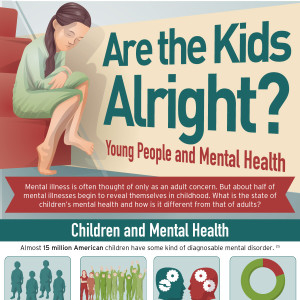Are the Kids Alright? Young People and Mental Health
Mental illness is often thought of only as an adult concern. But about half of mental illnesses begin to reveal themselves in childhood. What is the state of children’s mental health and how is it different from that of adults?
Children and Mental Health
Almost 15 million American children have some kind of diagnosable mental disorder. (1)
4 million
American children and adolescents with a serious mental disorder (2)
2 in 10
Children 9-17 with any diagnosable mental or addictive disorder that causes at least minimal impairment (2)
1 in 2
Mental disorders that begin by age 14 (2)
In any given year, only 20% of children with mental disorders are identified and treated. (2)
Most common disorders among children 8-15 (percentage in age group with disorder) (3)
ADHD: 8.6%
Mood disorder: 3.7%
Major depression: 2.7%
Conduct disorder: 2.1%
Depression: 1%
Anxiety disorder: 0.7%
Panic disorder: 0.4%
Generalized anxiety disorder: 0.3%
Eating disorder: 0.1%
Ripple Effects
Mental health problems can lead to issues with family and school — and can even lead children to attempt suicide.
Suicide
Featured Programs
Suicide is the third-leading cause of death for people age 15-24. Suicide kills more Americans in this age group than these causes combined: cancer, heart disease, AIDS, birth defects, stroke, pneumonia, influenza and chronic lung disease. (2)
9 in 10
Children and adolescents who commit suicide who have a mental disorder (2)
School problems
1 in 2
Students 14 and older with a mental illness who drop out of high school (2)
Legal trouble
Youths in juvenile detention with at least one mental illness (2)
Boys: 65%
Girls: 75%
Identifying and Treating the Problem
Early identification and adequate treatment can quite literally be the difference between life and death for young people with mental illness.
Signs of mental illness
Signs can vary depending on the disorder and age of the child.
Common signs of mental health trouble, by age group: (4)
Age 4-7, preschool/early elementary years
- Bad behavior at preschool or daycare
- Hyperactivity outside of what other children are doing
- Insomnia
- Persistent nightmares
- Excessive fear, worrying or crying
- Extreme disobedience or aggression
- Lots of temper tantrums all the time
Age 7-11, grade school years
- Inconsistent friend group
- Excessive fear and worrying
- Extreme hyperactivity
- Sudden drop in school performance
- Loss of appetite
- Sudden weight changes
- Obsession over weight
- Sudden change in sleep habits
- Visible and prolonged sadness
- Visual or auditory hallucinations
Age 11-19, tween and teen years
- Other common signs on either list above
- Destructive behavior
- Repeatedly threatening to run away
- Self-harm
- Withdrawal from family or friends
- Troubling writings or art that suggest desire to harm self or others
Treatment
Though children’s brains are still in a state of development, adequate treatment of mental disorders can help put a young person on a path to a healthy future.
Most common treatment options (1, 5)
- Medication
- Psychotherapy
- Cognitive behavioral therapy
- Art therapy
- Animal-assisted therapy
- Group therapy
Sources:
1. http://www.apa.org
3. http://www.nimh.nih.gov
4. http://www.everydayhealth.com
5. http://www.kidsmentalhealth.org

